Key Insights
- As of Q3’23, 1,322 subgraphs have been published from The Graph’s hosted service to the decentralized network, up 22% QoQ.
- The Graph has completed the last phase of the L2 migration of its protocol smart contracts to Arbitrum One by enabling the transfer of delegations, subgraphs, curation signals, and indexer stakes.
- While query volume on The Graph increased 39% in Q3’23, demand-side revenue in USD decreased 52% QoQ, primarily driven by optimizations in query pricing.
- Revenue from indexing rewards decreased 19% QoQ to over 7.3 million USD in Q3’23. Delegators received 65% of the total indexing rewards distributed in Q3’23.
- The Graph’s active Indexers decreased 41% QoQ, while Delegators and Curators grew 247% and 5%, respectively.
Primer on The Graph
The Graph is an indexing protocol that provides onchain data to consumers from a wide spectrum of sources. It removes the need for data consumers (e.g., app developers) to build out complicated infrastructure to get onchain data. Instead, data consumers pay to query APIs of onchain data — called “subgraphs” — via the GraphQL API.
To ensure the protocol runs correctly and efficiently, The Graph network incentivizes several key roles within its ecosystem of both technical and non-technical participants:
- Indexers process and store onchain data from subgraphs. They usually have advanced technical knowledge to operate nodes. In return, Indexers receive query fees from data consumers and indexing rewards from new token issuance.
- Curators are economically incentivized to analyze and signal which subgraphs are valuable to index. Curators earn a 10% portion of the query fees generated by particular subgraphs.
- Delegators do not employ resources to index onchain data; instead, they delegate The Graph’s native utility token GRT to Indexers. In return, Delegators earn a portion of query fees and indexing rewards without running nodes themselves.
As of Q3’23, The Graph’s decentralized protocol and hosted service support seven networks: Ethereum, Polygon, Arbitrum, Avalanche, Fantom, Opera, Gnosis Chain, and Celo. The L2 migration of The Graph’s protocol smart contracts to Arbitrum has been finalized in Q3’23.
Key Metrics
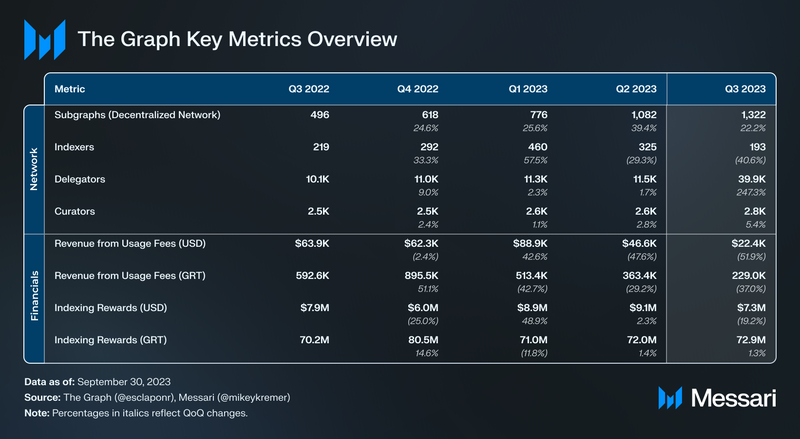
Performance Analysis
The Graph Network is based on the relationship between subgraph developers and data consumers that pay to query subgraph data. The performance of the network can be measured by the growth of active subgraphs, the network’s revenue in query fees, and the activity of the key ecosystem participants: Indexers, Delegators, and Curators.
Usage
Subgraphs
To bootstrap The Graph, a hosted service was initially created. This service hosts subgraphs as the protocol gradually transitions to its decentralized network. The hosted service is free (subsidized by The Graph ecosystem) and consists of indexing infrastructure run by Edge & Node, the initial team behind The Graph. The first subgraph launched on the decentralized network in Q1’21. As of Q3’23, The Graph is a hybrid of its hosted service and decentralized network.
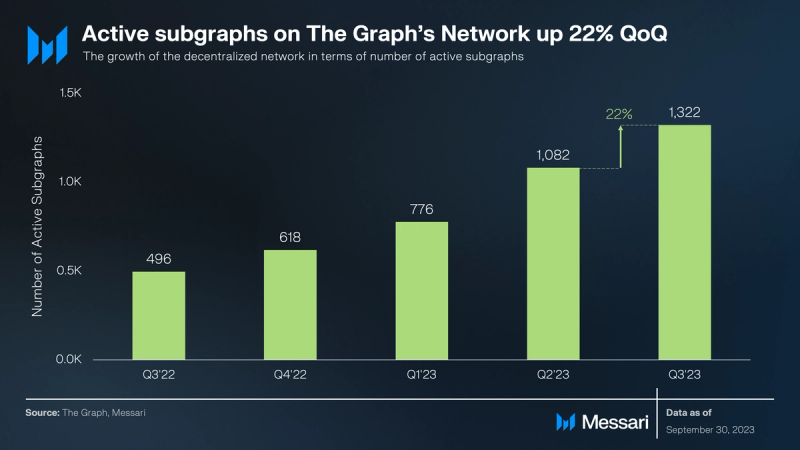
Over the past five quarters, the number of subgraphs launched on The Graph’s Network has grown steadily. As of September 2023, there are 1,322 active subgraphs on the decentralized network, which is a 22% increase QoQ from 1,082 at the end of Q2’23. Unlike the hosted service, The Graph Network requires data consumers to pay a fee per query to Indexers. These query fees are further distributed by Indexers to Delegators and Curators.
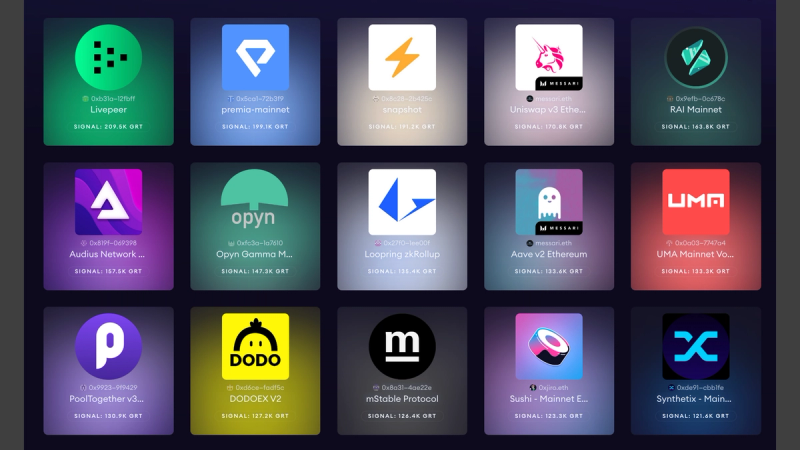
Source: The Graph Explorer
Curators are incentivized to signal subgraphs that are of a high quality. The Graph then indexes these subgraphs to earn a share of the query fees generated by subgraphs. The amount of GRT signaled toward a subgraph represents the market’s prediction for future query volume on a subgraph. Curators currently signal the highest amount of GRT toward the Premia, Livepeer, and RAI subgraphs.
Over the next several quarters, the number of deployed subgraphs on The Graph’s Network is expected to increase. The Graph community aims to migrate all subgraphs from the hosted service to its decentralized network, as more chains integrate with the decentralized network. During the migration, other key metrics on The Graph should also improve, ranging from ecosystem participation to the demand-side revenue generated from query fees.
Ecosystem Participation
Subgraphs provide an arena for both technical and non-technical ecosystem participants to interact symbiotically:
- Indexers operate Graph Nodes to process and store onchain data. Data consumers can then query this data via GraphQL, an open-source language for The Graph’s APIs.
- Curators signal to Indexers which subgraphs are worth indexing. Curators also often act as subgraph developers.
- Delegators are ecosystem participants who may lack the technical know-how or resources to index; they may choose to delegate GRT to Indexers.
Staked GRT is required for indexing subgraphs. As Indexers receive more GRT via delegation, they increase their capacity to index a larger number of subgraphs on the network. Indexers monetize their indexing and query processing services on The Graph’s query market by staking GRT. The minimum stake for an Indexer is currently set to 100,000 GRT (roughly $9,000 as of September 30, 2023). On top of this minimum, Indexers can also receive delegated stake from other ecosystem participants. Delegators can increase their total stake up to 16x an Indexer’s personal stake.
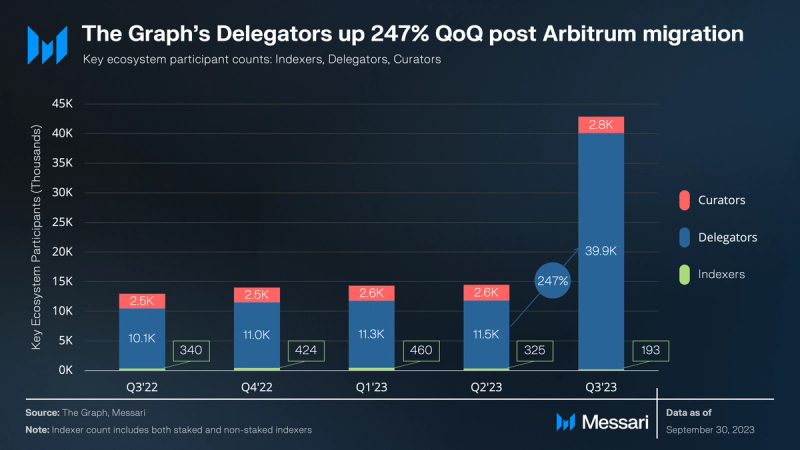
While Curators saw a moderate growth of 5%, the number of Delegators jumped by 247% in Q3’23. This increase in the number of Delegators from 11,500 in Q2’23 to nearly 40,000 in Q3’23 was driven by a Coinbase Earn campaign. Before the end of Q3’23, approximately 25,000 new Delegators originated from participation in the Coinbase Earn campaign. These new participants added ~6.2 million GRT in delegation through the end of Q3’23 and were paid out ~4.3 million GRT through the campaign. While there were 114 Delegators on Arbitrum in Q2’23, Q3’23 saw a massive increase to over 28,000 Delegators on Arbitrum, with a total stake of over 800 million GRT. Simultaneously, Delegators on Ethereum remained stable at 11,500 in Q3’23, with a total stake of 1.1 billion GRT.
Simultaneously, Indexers actively staking GRT decreased 27% to 238 at the end of Q3’23. This decrease can be attributed to the conclusion of The Graph’s Multi-Chain Incentivized Program at the end of Q1’23 as well as to some Indexers simultaneously un-staking their GRT. This behavior hints at the potential dependency of Indexers on reward incentives as they seek to balance operating costs and accruing revenue from staking GRT and servicing queries on The Graph’s network.
Revenue
The GRT token follows the Stake-for-Access model, also known as a utility token model. Participants in The Graph’s ecosystem earn revenue in GRT by performing work in the form of indexing and querying services on the decentralized network. Both services require GRT to be staked. Indexers’ stake comprises their own GRT tokens (i.e., self-stake) and GRT delegated toward them (i.e., delegated stake).
The two main sources of revenue for The Graph are indexing rewards and query fees paid by data consumers. Revenue from both indexing rewards and query fees is funneled through Indexers who then distribute it to Delegators and Curators.
Every Indexer is free to define their own individual cut of query fees and indexing rewards, based on the supply-and-demand dynamics of the open marketplace. According to this individual cut, each Indexer then distributes the indexing rewards and query fees with Delegators, whereas the Curators earn a 10% portion of the query fees generated by particular subgraphs.

Source: The Graph: Choosing Indexers
As per the above example, if an Indexer set the query fee cut to 13.96%, their Delegators would receive the remaining 86.04% of the fee revenue proportional to their stake. While Delegators’ stake cannot be slashed, Delegators should still consider several factors when staking GRT with Indexers. These factors relate to:
- Indexer choice, i.e., choosing effective Indexers with the most optimal balance between reward payouts and “skin-in-the-game” from allocation of self-stake.
- Unbonding period, i.e., no GRT transfers or rewards are possible within a 28-day window after un-delegation.
- Delegation tax of 0.5%, i.e., calculating how long it takes to earn back the 0.5% tax on delegation.
Indexing Rewards
Indexing rewards come from a 3% annual inflation in the GRT supply, derived from the GRT issuance rate. Rewards are distributed to staked Indexers in return for providing indexing and querying services on The Graph’s open marketplace.
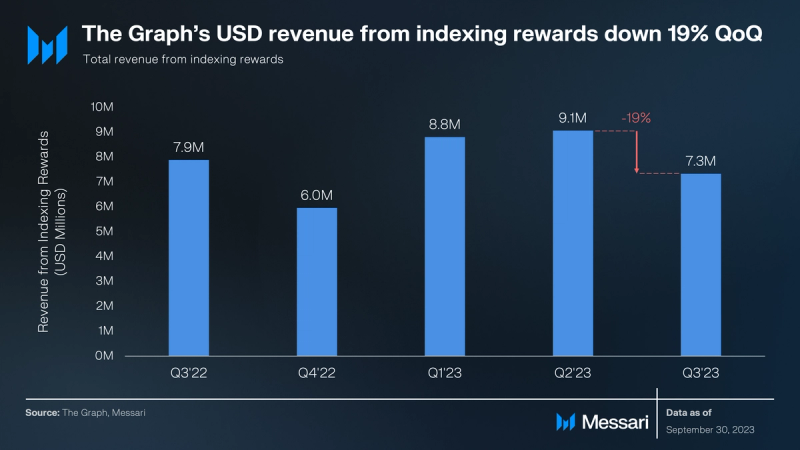
Indexing rewards decreased 19% QoQ to approximately $7.3 million in Q3’23, mainly driven by the decrease in USD price of the GRT token. In GRT terms, indexing rewards remained relatively stable, up 1% QoQ from 72 million GRT in Q2’23 to nearly 73 million GRT in Q3’23. This stability in the issuance of indexing rewards is a consequence of the governance decision to set the protocol issuance rate to The Graph’s original 3% prior to The Merge in September 2022.
For context, the number of blocks created on Ethereum increased following The Merge. As a result, the GRT rewards issued per block increased to 3.2% for approximately one month in Q4’22. The increase led the overall quarterly rewards to reach 81 million GRT ($6.0 million). Following Q4’22, quarterly indexing rewards varied from 71 million GRT ($8.8 million) in Q1’23 to 73 million GRT ($7.3 million) in Q3’23.
Over the past five quarters, Delegators received more GRT indexing rewards than Indexers themselves. In Q3’23 alone, Delegators were rewarded over 47 million GRT (roughly $4.8 million). This amounted to approximately 65% of the total indexing rewards distributed, up from 64% in Q2’23. Simultaneously, Indexers received roughly 26 million GRT indexing rewards (roughly $2.6 million).
Query Fees (Network Usage Fees)
While the bulk of Indexer earnings come from rewards, the second source of network revenue comes from query fees. Data consumers (e.g., app developers) payquery fees for Indexers to fetch and organize data. Query fees are determined by market demand and distributed to Curators, Indexers, and Delegators.
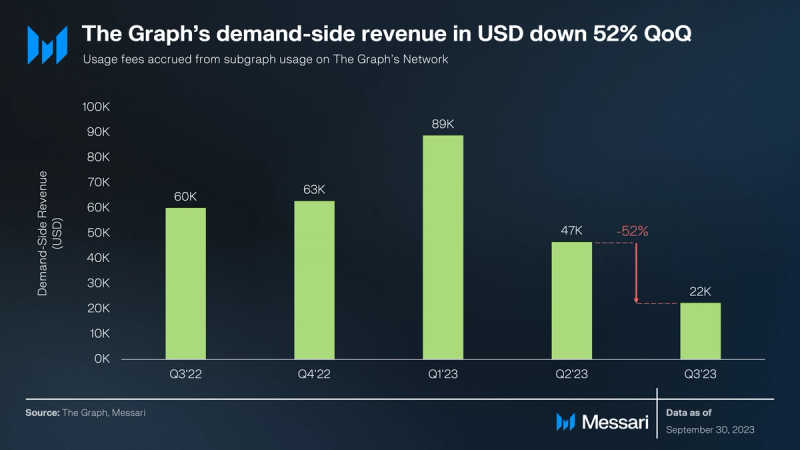
Total revenue from query fees decreased 52% QoQ in USD terms, after reaching an all-time high in Q1’23. This decrease in demand-side revenue in USD has been primarily driven by optimizations in query pricing.
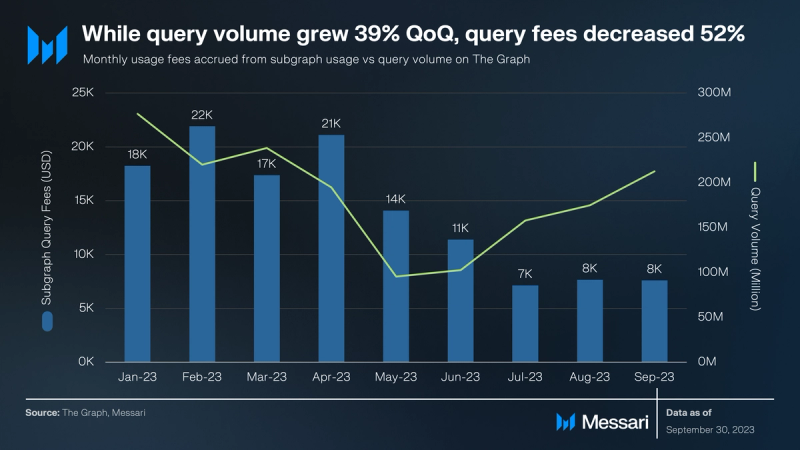
Indeed, when overlapping the monthly revenue from query fees against the query volumes, it appears that query volumes reverted the downward trend from Q2’23 and increased to 545 million in Q3’23, up 39% from 393 million in Q2’23.
For The Graph, the Q3’23 total revenue from query fees (over $22,000) made up 0.3% of the total revenue from indexing rewards (approximately $7.3 million). This distribution indicates that The Graph’s network participants still highly rely on indexing rewards for sustaining their day-to-day operations.
Qualitative Analysis
Releases
Chain Integration Process (CIP)
In late August, The Graph Foundation introduced the Chain Integration Process (CIP) – a community-led initiative to integrate more chains into The Graph Network. This approach succeeds the Multi-Chain Incentivized Program, which laid the groundwork for the CIP. The Chain Integration Process consists of three main steps:
- Submit Integration Proposal: Initiators start the process by creating a thread in The Graph Forum. They must ensure chain compatibility with the Graph Node, and if the EVM JSON-RPC interface is missing, a new Firehose implementation is required.
- Test and Validate Integration: After the proposal, a focus is placed on quality integration and thorough testing. Collaborations with core developers and community members, such as IndexerDAO, will be central in this phase.
Apply for Mainnet Integration: After validation on the testnet, details of the new data source are updated, and a Governance Improvement Proposal (GIP) is drafted to seek official protocol support for indexing rewards.
Migration to Arbitrum
The Graph has completed phase three of the migration to Arbitrum One. Following the release of all L2 Transfer Tools, it now allows network participants to move to Arbitrum One. These tools simplify the process of transferring delegations, subgraphs, curation signals, and indexer stakes.
Substreams-Powered Subgraphs
In mid-July, The Graph introduced Substreams, a processing engine capable of consuming dense streams of blockchain data. Substreams then refines and shapes the data to be quickly digested by end-user applications. Substreams-powered subgraphs combine the power of Substreams with the ability to query subgraphs. By integrating Substreams into the Graph Network, developers have the ability to offer high-speed indexing and distribute their data to any location. They can also improve syncing speeds and use advanced techniques for storing and processing blockchain data. The result of these improvements includes a syncing time that’s over 100 times faster and an overall increase in performance.
Key Decisions
Gradual Increase of L2 Rewards (GGP 0030)
This successful proposal increased the L2 rewards to 50% and reduce the L1 issuance accordingly, as outlined in GIP 0052. The proposal took effect on Sept. 25, 2023.
Replacing Bonding Curves with Indexing Fees (GIP 0058)
This proposal aims to enhance the efficiency of The Graph’s indexing process by replacing the current curation mechanism with a new system of indexing fees. The objective is to establish seamless coordination between Indexers and developers for subgraph indexing, contributing to the development of robust decentralized applications.
The proposed mechanism involves Indexers publicly setting prices for subgraph indexing work, allowing consumers to select Indexers or delegate this choice to algorithms. Selected Indexers complete the indexing and provide verifiable work records, receiving payment based on the agreed price and work units. This shift promises benefits like fair compensation tied to resource intensity, stable Indexer revenue, and a clear relationship between consumer payments and service quality. Ultimately, the mechanism should help foster an efficient and scalable indexing services marketplace.
The Graph’s Technical Advisory Board
The Graph Council has shared plans to form a Technical Advisory Board (TAB), “whose responsibility is to support core contributors to accelerate R&D efforts by collaborating with The Graph Council and the wider ecosystem in reviewing technical plans, proposals, and implementations.” The TAB is intended to review GIPs thoroughly and “increase the confidence of the community and The Graph Council in approving more technical proposals and software upgrades when they reach the final review stage.”
The board will initially start with five members selected by The Graph Council. Community members are invited to nominate themselves or others by using a template to complete an application in response to this forum thread by Oct. 20, 2023.
A full list of The Graph events and decisions can be accessed via Messari Intel.
Closing Summary
The last phase of the L2 migration of The Graph’s smart contracts to Arbitrum One was completed in Q3’23. Over the quarter, The Graph saw a 52% QoQ decrease in demand-side revenue in USD, primarily driven by optimizations in query pricing. Simultaneously, query volume on The Graph increased 39% QoQ. Revenue from indexing rewards decreased 19% QoQ to over 7.3 million USD in Q3’23. Delegators received 65% of the total indexing rewards distributed in Q3’23. The Graph’s active Indexers decreased 41% QoQ, while Delegators and Curators grew 247% and 5%, respectively.
Over the last year, The Graph has been focused on the migration from a hosted service to a decentralized network. As of Q3’23, 1,322 subgraphs have been published from The Graph’s hosted service to the decentralized network, up 22% QoQ. As more subgraphs are migrated to the decentralized network in the coming quarters, The Graph will continue to remove technical barriers for developers, ultimately leading to faster innovation across Web3.
















